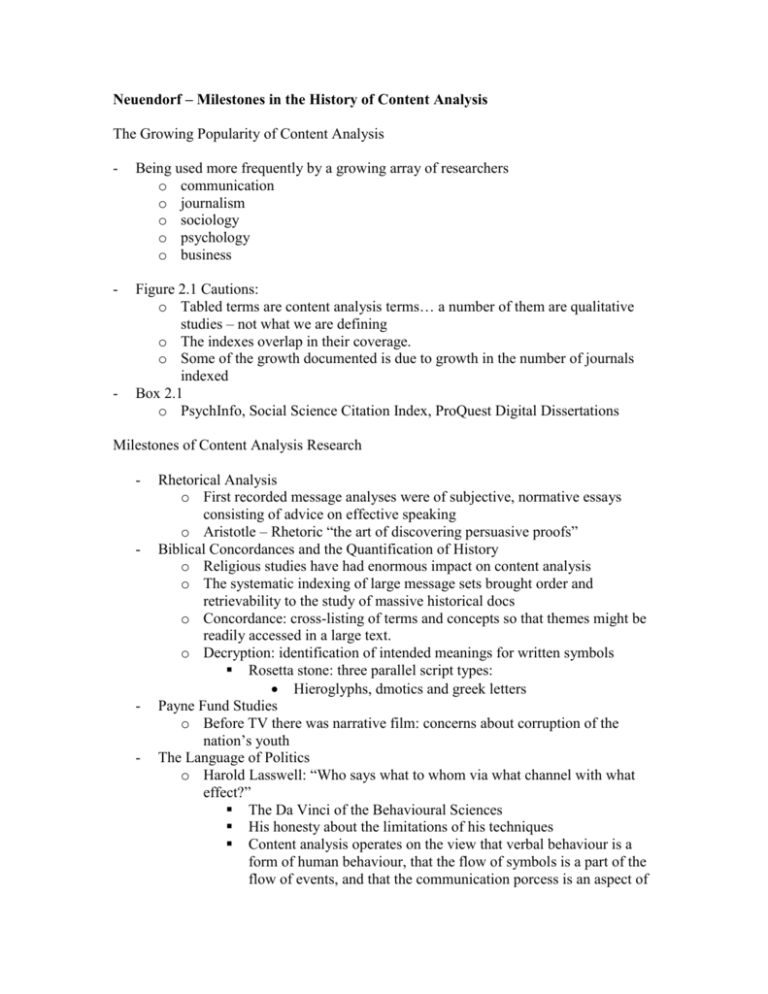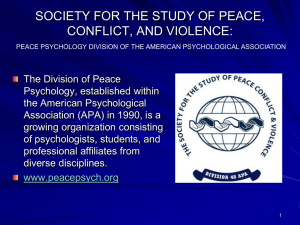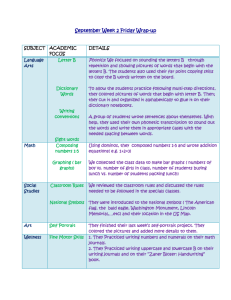Chapter 2
advertisement

Neuendorf – Milestones in the History of Content Analysis The Growing Popularity of Content Analysis - Being used more frequently by a growing array of researchers o communication o journalism o sociology o psychology o business - Figure 2.1 Cautions: o Tabled terms are content analysis terms… a number of them are qualitative studies – not what we are defining o The indexes overlap in their coverage. o Some of the growth documented is due to growth in the number of journals indexed Box 2.1 o PsychInfo, Social Science Citation Index, ProQuest Digital Dissertations - Milestones of Content Analysis Research - - - - Rhetorical Analysis o First recorded message analyses were of subjective, normative essays consisting of advice on effective speaking o Aristotle – Rhetoric “the art of discovering persuasive proofs” Biblical Concordances and the Quantification of History o Religious studies have had enormous impact on content analysis o The systematic indexing of large message sets brought order and retrievability to the study of massive historical docs o Concordance: cross-listing of terms and concepts so that themes might be readily accessed in a large text. o Decryption: identification of intended meanings for written symbols Rosetta stone: three parallel script types: Hieroglyphs, dmotics and greek letters Payne Fund Studies o Before TV there was narrative film: concerns about corruption of the nation’s youth The Language of Politics o Harold Lasswell: “Who says what to whom via what channel with what effect?” The Da Vinci of the Behavioural Sciences His honesty about the limitations of his techniques Content analysis operates on the view that verbal behaviour is a form of human behaviour, that the flow of symbols is a part of the flow of events, and that the communication porcess is an aspect of - - - - the historical process … Content analysis is a technique which aims at describing, with optimum objectivity, precision and generality, what is said o a given subjet in a given place at a given time. The Fine Art of Propaganda (Lee & Lee 1939) The War at Home: Advances in Social and Behavioural Sciences Methods Druing WWII o The war was marked by unprecedented cooperation between private industry, government and the scholarly research bodies. o WWII gave the social sciences a remarkable level of acceptance o US War Dept.’s Information and Education Division conducted a series of experiments on the effectiveness of some of the seven-lart Why We Fight series of training and indocrination films produced for the military by Frank Capra. The films didn’t work: no patriotism Audience measurement techniques were developed. Indiviudal differences research flourished. o Code breaking and surveillance used content analysis Speech as a Personality Trait o Edward Sapir: famous linguist, anthropologist and psychologist. Human personality traits can be discerned from communication content o Gordon Allport (1942, 1965): Psychometrics (the measurement of psychological traits and states) Clinical Diagnoses o 1950s: Psychology starts to use formal content analysis o 1990s: it is generally accepted as a diagnostic method Department of Social Relations at Harvard o Used computer text analysis to content analyze written messages from: Linguistics, psychology, anthropology and communication perspectives Harvard Third Psychosociological Dictionary – coded 3,564 different target words with 83 different tags (job role, clothing, body part) Stanford Political Dictionary Davis Alcohol Dictionary o These lexicons are vital to modern content analyses. Television Images: Violence and Beyond o 1920s and 1930s – It was all about the movies o 1950s – TV took over! Content analysis was used to study violence in TV o George Gerbner and his Cultural Indicators Project Team Frequency and types of violence on US entertainment television began in 1967 It has found that TV violence is always higher than everyday violence - - This research involved studying the moving image: they had to move beyond simple text and develop new methods that considered nonverbal and other behaviours, artefacts and even production techniques. The Power of Computing o Advances in technology have pushed content analysis forward. o There will never be automatic content analysis The Global Content Analysis Village o 1955 Allerton House Conference found: Attendees across disciplines were concerned with issues related to using content analysis to make inferences about sources or receivers and with the trend toward going beyond “simply counting the frequency of words or other symbols.” Lacy, Fico & Riffe – Introduction











